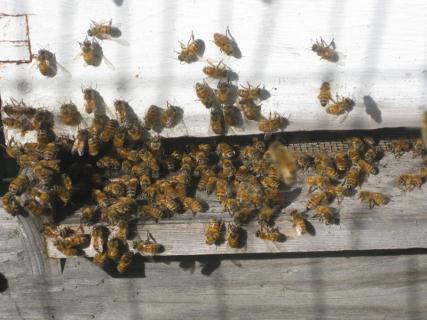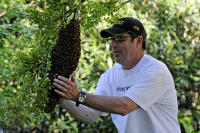I am looking for bee swarms to collect. If you see any, please give me a call or email me.
The buzz: Honeybees are swarming, and that's a good thing

By Mike Taugher
Contra Costa Times
Posted: 04/19/2012 07:42:39 PM PDT
Updated: 04/20/2012 06:30:14 AM PDT
Click photo to enlarge

Beekeeper Mike Stephanos, of Walnut Creek, inspects a three pound swarm... ( JOSE CARLOS FAJARDO )
Large swarms of honeybees are generating lots of buzz this spring, but there is no reason for alarm, Bay Area beekeepers say. There is an increase in the number of swarms, but they attribute it to the weather and nothing unusual.
"This happens every year, but some years are more bountiful than others," said Rick Kautch, past president of the Mount Diablo Beekeepers Association. "It's definitely a good year. We're getting a lot of calls."
Kautch and other beekeepers attributed much of the apparent increase to the weather -- the late rains followed by sunshine and blooming plants caused a lot of bees to swarm all at once, they said.
"I've collected 12 in the last two weeks," said Mark Paterson, vice president of the Santa Clara Valley Bee Guild. "We don't (usually) get that many that quickly."
But one honeybee expert was skeptical. Eric Mussen at UC Davis said he's been getting the same number of calls as normal.
What has changed, Mussen said, is that he is no longer hearing from people as he did in the late 1990s and early 2000s that there were no bees at all out in the fields -- a nationwide bee decline attributed to a parasitic and disease-spreading mite that was followed in the mid-2000s by a mysterious phenomenon of collapsing bee colonies.
"Things have been going back to normal," Mussen said.
When a hive becomes overcrowded, the queen bee and as many as half or more of the bees in the hive will leave in a swarm, leaving a daughter queen and the other bees behind.
Unlike the cartoons, those swarms of honeybees are not dangerous, beekeepers say. The bees, which can number 20,000 to 30,000 in a swarm, have gorged themselves before they leave the hive and are content. They also have no territory or young to protect when they are on the move, beekeepers said.
The swarm will typically ball up somewhere and send out scout bees to find a location for a new hive.
The swarming typically occurs from mid-April through May, said Mussen.
Bay Area beekeepers said the late rains suppressed swarming for a while, and when the weather turned pleasant the swarming started at once.
The weather may also have triggered a response in bee hives to more pollen or nectar in bees' surroundings, some beekeepers said.
One beekeeper said the recent popularity of beekeeping may also be contributing because there are more sources for bee swarms, even though most beekeepers would prefer to keep their bees at home.
"Backyard beekeeping is more popular," said Jeff Roller, who's been a beekeeper in Oakland for seven years.
Beekeeping associations are usually happy to come collect a swarm, which they can use to start a new hive. They might charge a fee or ask for a donation.
Bay Area counties each have their own beekeeping associations or guilds that have contact phone numbers on their websites.